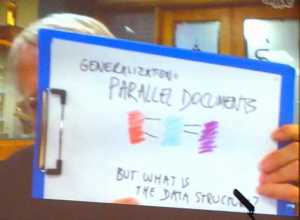Are we able to model activities of humanities scholars in a formal way? How can literature be represented in new ways on the Web? And how can we support the work of humanists with new innovative tools? These questions were addressed during the event “The Web as Literature” which took place on June 10th at the British Library in London. The event was co-organized by the Digitised Manuscripts to Europeana (DM2E) and Judaica Europeana projects which are both EU-funded projects that provide new content and technologies to the European Digital Library Europeana. Within DM2E, a conceptual model was created which can be used to represent activities and objects of humanists. This Scholarly Domain Model was part of a discussion moderated by Vivien Petras. More general aspects of modelling, including what kind of models exist, as well as practically used examples like the Europeana Data Model (EDM) and the CIDOC-CRMwere additionally addressed. The CIDOC-CRM is a real-world model that is used by the British Museum to represent their data. A common critique on the model is that it is too complex but Dominic Oldman stressed out that it is not CIDOC-CRM which is complicated – it is the data that the model tries to represent. The EDM on the other side uses very general elements but can be specialized for specific smaller domains, as it is done in DM2E for the domain of manuscripts.
The second half of the event was focused on tools and activities in the Digital Humanities. Robyn Adams and Bernhard Haslhofer have won this year’s DM2E Open Humanities Award and presented their developments: Linked Data and visualisations from the Diplomatic Correspondence of Thomas Bodley (1585-1597) project and the MapHub tool that enables annotations of old maps and more. Christian Morbidoni from DM2E demonstrated Pundit, a tool with which semantic annotations can be made.
Ted Nelson showing one of his handwritten slides during the remote keynote at the “Web as Literature” event.
Photo by Dominic Oldman, researchspace.org.
The organizers of the event were able to get Ted Nelson, the inventor of the Hypertext, as keynote speaker. Nelson talked about the limitations of paper and the current Web. His presentation “See the connection? Toward a WYSIWYNC literature” was about multipage documents where one can directly see from which other document quotations or links come from due to parallel views on documents. All different kinds of documents can be shown in one client, the Xanadu space. Nelson concluded his talk with the resolution of the abbreviation WYSIWYNC: What you see is what you never could – on paper! His appeal was to stop imitate paper on the Web but rather use new forms of documents like it is done in his Xanadu approach. The DM2E project, the Open Humanities awards winners and others are working on similar ideas and already by using Linked Data standards, we are a step further in creating new tools that support today’s scholars. This may finally lead us to use more of the Webs potential.
For all those who weren’t able to be there, you can see a recording of Ted Nelson’s talk here:
Ted Nelson: “See the Connection? Toward a WYSIWYNC Literature” from DM2E on Vimeo.


Comments are closed.